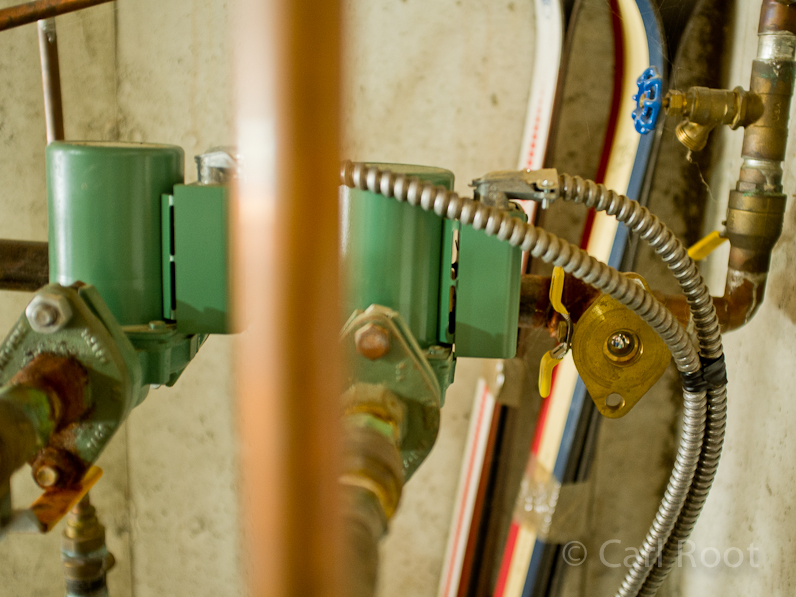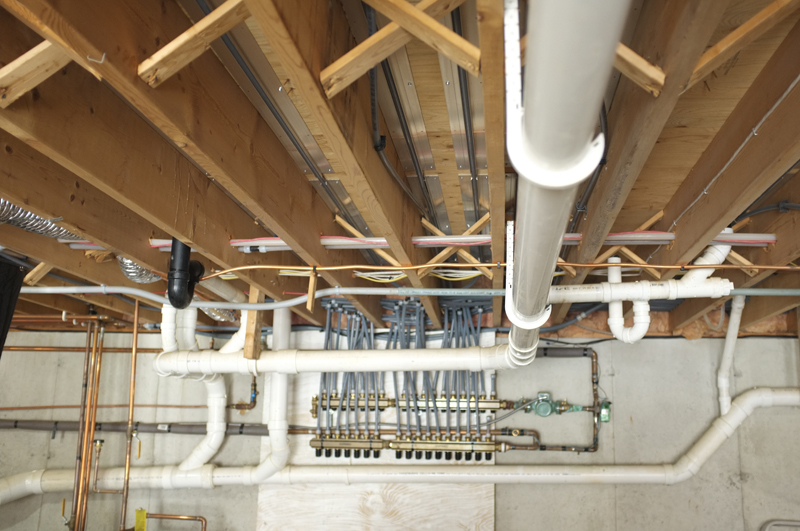Welcome! Here are the website rules, as well as some tips for using this forum.
Need to contact us? Visit https://heatinghelp.com/contact-us/.
Click here to Find a Contractor in your area.
If our community has helped you, please consider making a contribution to support this website. Thanks!
Modifying a Two-Zone System
Options
seniorblues
Member Posts: 23
I have a ten-year-old well-insulated house with propane radiant heat. The upstairs has baseboard units; the main floor has radiant heat below the oak floor. Tubes are mounted on the plywood subfloor between the floor joists The full basement ceiling is exposed, although roughly 60% of the surface area is covered with a foil insulator/reflector.
I have recently installed a wood stove on the main floor which is now the primary heat source for most of house. The basement, however, is quite cold, so I'm considering removing all the foil reflectors and putting the thermostat in the basement.
My question is, if I set the thermostat in the basement to sixty degrees, what would you expect the room temperature to be on the main floor (without the wood stove)?
I have recently installed a wood stove on the main floor which is now the primary heat source for most of house. The basement, however, is quite cold, so I'm considering removing all the foil reflectors and putting the thermostat in the basement.
My question is, if I set the thermostat in the basement to sixty degrees, what would you expect the room temperature to be on the main floor (without the wood stove)?
0
Comments
-
If my idea doesn't work, I do have the option of adding another zone, but I have no idea what to do with it.

0 -
-
Bellow 60 you have to use some comen sence. I'm not sure why you want to remove the radiant from first floor. Sounds like you have another problem and don't know what it really is yet. With that being said, I have to ask what's wronge with the radiant on the 1 st floor.0
-
The other thing I forgot to mention is that the floor isn't insulated 100% that's one reason why it's not working properly.0
-
I don't understand the" common sense below 60" comment . . .
I no longer need heat on the first floor - the wood stove works beautifully - but I'm quite sure that removing the foil won't dramatically reduce the heat transferred to the subfloor. On the contrary, my concern is that cranking the basement up to 60 may result in the 1st floor getting uncomfortably hot.0 -
Regarding your second comment, the system works fine. Without the stove, we're quite comfortable . . . until we go down to the basement. At the moment, it's fifty degrees. Outside, it's sixteen.0
-
Without the insulation and the plates there the heat should go down. The heat will find the path of least resistance. For us to give a spacific temp that's hard to do. What you may want to do, but I'm not 100% sure it's the correct thing to do is remove the aluminum heat transfer plates and but insulation inbetween the wood and the pex so all the heat comes down stairs.
I know I'm going to sound like a Monday mornong quarterback, but why didn't you leave the first floor alone and put the stove in the basement if the first floor was fine.
Again not trying to be rude just trying to find out why you want to take a perfectly working radiant floor system and not use it for what it was designed for.0 -
A fair amount of heat from the stove on the main floor goes up the stairs to the second floor, although it doesn't reach the farthest corners as well, of course. The other reason to put the stove in the main floor, besides the fact that installation in front of a fireplace was easy, is that the basement doesn't need to be heated except when it is in use. The wood stove would be running 24/7 except that I don't have enough wood set aside.
I would think that removing the aluminum heat transfer plates, as you have suggested, or leaving them in place and sliding the foil between the PEX and the shield would work, although I wonder if the system would become a lot less efficient without the heat distribution benefits of the plates.0 -
Don't quote me but I think i know what your thinking.
The plates don't generate more heat, what it does is make the heat tranfer evenly on first floor. but your not going up anymore your going down.
What's the supply water temp and what gpm are you moving the water?0 -
I understand about even distribution of heat. Couldn't find anything that might tell me water temp or gpm.
0 -
Everything most of us techs do on these jobs are all done by math formulas. If we don't know what temp the water is or how fast it's traveling, it's hard to determine what's going on. Also how many loops and how long the loops are? But if I were you I would do what you said put insulation inbetween wood and plates, the heat should come down.0
-
Depending on where you are in the country, if it stays really cold for a week, your house will probably freeze up and something will break.
That's what usually happens when people put in wood stoves to try to save money on heat. In your case, I think you had a really poor performing system, and you just put a band aid on an infected broken bone.
That reflective bubble wrap "insulation" is as useless as breasts on a hen chicken. If you went down to Sally's and got some old blankets and nailed them to the bottom of the floor, it would be more effective as an insulator.0 -
Sounds like you are considering turing the radiant floor into a radiant ceiling for the basement, correct?
It's tough ton predict how much of thereat energy will travel down. Then transfer plates are still trying to move energy to the floor above.
Removing the insulation will no doubt transfer some energy to the colder basement level, hot goes to cold, and a % to the floor above.
Try it with the insulation removed to see how the balance works.
i hate to see you remove the radiant system, I don't think that is what you are considering?Bob "hot rod" Rohr
trainer for Caleffi NA
Living the hydronic dream0 -
I just did some research on reflective foil and found that it gets a bad rap because it's often misused and improperly installed. Since we're talking about radiant heat, it's not about 'R' value.
Let me be clear . . . I don't think my system is ineffective or deficient in any way. The original installation makes it easy to add a third zone, as you can see in the picture. This is an unheated, unfinished basement. I don't know why foil isn't installed throughout, but I think the best thing to do is remove all of it and move a thermostat into the basement. I agree with the observation that you want to be able to maintain a minimum temperature if you leave for a week during the winter, and I think what I'm planning will satisfy that requirement, although at a slightly greater cost because I'll have to raise the temperature of the basement higher than is necessary.
0 -
If plan 'A' doesn't work, what sort of system would you add as the third zone off the furnace? An additional radiant system suspended from the ceiling seems redundant, but at least you would be able to control it separately.0
-
Id insulate the floor better then throw baseboard around the basement. Also just a question because I don't know your spacific situation. You said you put a wood burning stove In front of the fireplace. Why wouldn't you heat the first floor with the fireplace and then put the wood stove in basment. Then just add some baseboard or some wall panels in the basement.0
-
Fireplaces tend to be a net heat loss.
You're right about floor covering. That's on the "to do" list.
I would be interested in recommendations for wall panels. I'm assuming they don't have to be placed on an outside wall, which is the usual recommendation for baseboard units.0 -
So why not do this. Disconnect the current thermostat and remove the insulation. Get a new thermostat for the basement. A tekmar thermostat with a floor sensor. Install the floor sensor halfway between the tubes making sure you are not in contact with the plates. Router a nice groove out of the subfloor and cement the sensor in with wood putty. Mount the new thermostat on an interior wall not to close to any of the boiler piping.
The new thermostat w/floor sensor will give you the option the maintain the floor temp within certain parameters while attempting to heat the basement.
That's probably about the best you are going to do with your current approach.
If you have the boiler pipes insulated and they are in the basement, uninsulated them.
2 -
Sounds like a good idea.
Pipes are uninsulated.0 -
"" I just did some research on reflective foil and found that it gets a bad rap because it's often misused and improperly installed. Since we're talking about radiant heat, it's not about 'R' value. ""
The only bad rap that reflective bubble wrap gets is from those that know the advertising is total hogwash.
What does the "R" mean in "R"? Reflective? or Resistance?
The head AHJ where I worked asked that question when someone was claiming and installing it with the claim that it had the equivalent "R" value of R-30 insulation. The claimer was told to provide proof from the manufacturer. A Sales Rep called. He never provided the proof.
I did a few Staple Up jobs. In spite of telling the contractor, owner, and insulator that they MUST use foil faced insulation with a 2" air barrier between the tubes and the foil face fiberglass insulation, when I finally went back to check, they had craft faced insulation with the barrier down, and the fiberglass jammed up against the floor. And they all sucked as far as heating went.
That stuff is no better than the TV drugs advertised on TV. They'll never be advertised on radio because they won't have the time in the spot to list all the bad side effects.
0 -
I pulled down most of it this morning. The heat was on and you could feel the trapped warm air escaping as each section was removed. The temperature in the room rose from fifty to fifty-eight. There's a lot of fine tuning yet to be done, including installing a new thermostat downstairs, and what I've done may not be sufficient, but so far, I don't regret doing it.
We agree about incorrect installation of foil faced insulation.0 -
Good going, are you going to put insulation on ceiling and have all the heat come down.0
-
I don't think so. As Icesailor pointed out, you want to be able to heat the house when you're gone for a week, to make sure the pipes don't freeze.
0 -
A fan to circulate the air from floor to ceiling will go a long way to making the basement comfortable at this point.0
-
We have one, and I'll give it a try once we get the thermostat in place. The problem at the moment is getting the furnace to go on when you've got the stove cranked up upstairs.
I'm also thinking that part of the solution is to disconnect maybe half of the PEX tubes from the aluminum transfer plates to fine tune the percentage that heats the floor and the percentage that heats the basement. I would need a simple sort of hanger to keep them in place. Ideas?0 -
Here's a thought,where the plates are screwed into the ceiling loosen then so they have no contact to the wood, maby put a block on each end like a small 1 x 4 on each end then screw the plates to the new wood on each end that way the plates heat up but the tranfer just sinks. Or just use some type of hangers.
0 -
Stop a minute.
Do this in phases. Pull the bubble foil crap down do like Harvey suggested, and get the floor sensing thermostat.
See how that fairs. I gaurantee that the basement will be warmed how much is a question mark. The limiting factor will be overheating the main floor. But I think the basement being 50 ish more heat will travel down.
I really hate to see a perfectly good radiant floor system re cobbled to a half **** ceiling radiant configuration.
If there is an improvement but not enough. Fill the joist bays with insulation, and do ceiling radiant, or baseboards. You have the boiler just add another zone.
Someday you may get tired of packing wood.2 -
Pulling the reflective foil was easy, especially since I had only about 60%-70% coverage. Pulling some of the tubes out of the plates wouldn't be too much more trouble either, but more to the point, it's easily reversible. I may not be able or willing to deal with the wood stove on a daily basis when I'm older (I'm retired), and, as you say, messing up a perfectly good radiant heat system doesn't exactly add value to the house when it's time to sell.
Can anyone link me to an article on ceiling (or wall) options, if it comes to that?0 -
Not a problem if it comes to that. Unless finishing off the basement is in your plans you could go with baseboard you already have some on the second floor correct?
Other wise ceiling radiant will involve bumping the ceiling head room down a little for strapping to allow for the tubing, and plates then drywall.0 -
I will add I would not throw away that bubble foil it has some value just not what is claimed plus its expensive. If you decide a plan B reuse it with the radiant floor, but add R 19 batts below it. R 1 is 100% better than R 00
-
As you can see, this space was never intended to be "finished", at least as far as adding drywall is concerned. I suspect baseboard units are the answer, except that a contractor who came our recently wasn't too keen on having to run connector pipes up the concrete wall, across the ceiling, then back down the wall again between each baseboard unit.

0 -
What, is he lazy? A little more pipes to run, no big deal.seniorblues said:As you can see, this space was never intended to be "finished", at least as far as adding drywall is concerned. I suspect baseboard units are the answer, except that a contractor who came our recently wasn't too keen on having to run connector pipes up the concrete wall, across the ceiling, then back down the wall again between each baseboard unit.

0 -
I wonder if we're looking at a hybrid system . . . some sort of wall unit mounted on the concrete wall that you see in picture (west wall) and a more traditional baseboard series against the east wall which is a framed and finished wall with windows and sliding glass door.0
-
I'm looking for another opinion. He wanted to sell me a Mitsubishi split system - $4,600.0
-
If the space was , and is not intended to be finished off which I'm only seeing one area so I don't know the potential. You could still do ceiling radiant with plates, and no drywall. Look a little funky but it will still work as intended. This looks like fairly new construction from the pics. I will say they did a nice job on the present radiant floor install.
0 -
-
I thought they were going to send out the senior tech who's been here before. Instead, they sent out the young guy . . . .
Anyway, here's a different part of the basement. East wall on the left, poured concrete south wall to the right of the cinderblock fireplace support. The east wall is an obvious candidate for baseboard, but what about the concrete walls?
0 -
I see that as being finished space easily you could do both base board, and ceiling radiant.0
-
Alright, you want to condition the basement. First thing is to insulate it. Cinder blocks are about as porous as any building material you can find. Plus that have a texture and color that readily absorbs radiation.
Owens Corning makes some nice basement finishing solutions. Or you could frame a 2x4 wall on the inside and insulate.
If you attempt to heat the basement in it's current condition, you will waste a ton of heat energy.1 -
Base board would be kinda easy to do, where are you from again, maybe one of us from the wall can help you.0
Categories
- All Categories
- 87.4K THE MAIN WALL
- 3.2K A-C, Heat Pumps & Refrigeration
- 61 Biomass
- 429 Carbon Monoxide Awareness
- 120 Chimneys & Flues
- 2.1K Domestic Hot Water
- 5.8K Gas Heating
- 115 Geothermal
- 168 Indoor-Air Quality
- 3.7K Oil Heating
- 77 Pipe Deterioration
- 1K Plumbing
- 6.5K Radiant Heating
- 395 Solar
- 15.7K Strictly Steam
- 3.4K Thermostats and Controls
- 56 Water Quality
- 51 Industry Classes
- 50 Job Opportunities
- 18 Recall Announcements






